Artist
CAMPO DI MARTE
![]()
Enrico Rosa (guitar, vocals, mellotron)
Alfredo Barducci (horns, piano, organ, vocals)
Paul Richard (Ursillo) (bass, vocals)
Mauro Sarti (drums, percussion, flute, vocals)
Carlo Felice Marcovecchio (drums, percussion, vocals)
![]()
A band from Florence, Campo di Marte were another of
those band that despite a good recording deal with a major company (that
incidentally was the only
effort by United Artists to produce an Italian prog group), only released an
album and disappeared.
The group was formed in 1971 by guitarist Enrico Rosa and drummer/flutist Mauro Sarti,
that had previously played with minor groups like Senso Unico and La Verde
Stagione, along with American-born bass player Richard Ursillo (named Paul
Richard in the LP cover notes as it "sounded less Italian").
Keyboardist Alfredo "Carlo" Barducci was a trained French horn player,
and the large number of instruments played gave the new group the chance to mix
classical inspired rock music with various influences obtaining a rich and
varied sound.
A fifth member was added with drummer Carlo Felice Marcovecchio, that had
previously played with another very popular group from Florence, I Califfi,
and the presence of a second drummer left Sarti the freedom to play the flute in
many tracks.
The band had a good live activity, playing under
different names, and the final one, Campo di Marte (named after a quarter of
Florence), was found during the LP recordings.
Campo di Marte is a very good album, not
particularly original but very well composed, sung and played, with some orchestrated parts that
sometime remind the later work of Maxophone (with large use of flute and French horn). Good
guitar and keyboard playing throughout the LP make this an essential album in
any Italian prog collection. The seven tracks are sequentially named
(starting with Primo tempo up to Settimo tempo) as movements of a
symphonic composition.
By the way an extra track recorded during the LP sessions, entitled Si può
riuscire and planned to be released as a single, has never seen the light of
day. The album lyrics referred to the foolishness of wars,
and in contrast the cover contained a drawing of ancient Turkish mercenaries
injuring themselves to demonstrate their strength and courage. The same design
was contained in the band's posters.
Unfortunately a long time passed between the album composition and its recording and release, and the musicians had completely lost their interest in the band when it came out, aided by the total lack of promotion by the record company, that had also forced the band to change the songs lyrics. The group broke up immediately after the album release.
Guitarist Enrico Rosa (that was also the whole first
album composer) recorded a second Campo di
Marte, totally different from the debut LP,
but this was never released by United Artists, seeing this as an uncommercial
choice. A new line-up, including all musicians from Leghron (keyboardists Antonio Favilla ex-Capitolo
6 and
Franco La Placa, guitarist Fabrizio Ughi, bassist Sergio Ducilli, drummer Andrea Colli and sax and flute player Loriano Berti, also from Capitolo
6) often played live under the name Campo di Marte. Some tracks composed by Rosa and recorded with these musicians were included by the Picci label on an LP entitled The Physicians.
Rosa then moved to Denmark in 1974 and he's
still a professional musicians there, having had a long activity both as session
guitarist and as solo musicians in the jazz and classical music fields.
The others, except Favilla, kept on playing live as Campo di Marte until 1975.
Original bass player Paul Richard reappeared in Sensations' Fix with his real surname Ursillo, and has played with that band in all of their albums. He had played in the 60's with Florence band Chewing Gum (their previous name was Black Angels) with an interesting hard sounding single in 1968 (Senti questa chitarra/Tu sei al buio - RCA Talent T15). Even drummer Marcovecchio has collaborated with Sensations' Fix from time to time. Drummer Mauro Sarti later played with Bella Band, with an album on Cramps in 1978.
In 2003 the group was reformed by the original members Enrico Rosa and Mauro Sarti, along with Eva Rosa (recorder), Matin Alexandr Sass (keyboards) and Maurilio Rossi (bass), for some concerts in Tuscany and for the recording of the live CD Concerto zero. The double set included a 1972 concert recording, originally used on a promo-only LP made by the band, and the whole 2003 reunion set.
![]()
| LP | |||
| Campo di Marte | United Artists (UAS 29497) | 1973 | single flipback cover - lyric inner |
| AMS/BTF (AMSLP 01) | 2007 | reissue of the 1973 album - black or red vinyl - reissued again in 2021 with crystal clear vinyl | |
CD |
|||
| Campo di Marte | Mellow (MMP 181) | 1994 | reissue of 1973 album |
| AMS/BTF (AMS 101 CD) | 2006 | as above with mini-LP gatefold cover and different running order | |
| Concerto zero (Live 1972/2003) | BTF/Vinyl Magic (VMCD 088 A/B) | 2004 | 2CD set with a concert from 1972 and another from the reunion line-up in 2003 - mini gatefold cover with 2 booklets |
![]()
Not easy to find especially with the elusive lyric inner, Campo di Marte had a flipback cover as all the United Artists album of the 70's with CGD Italian distribution.
The album has been counterfeited, probably in late
80's, but the repro is easy to identify as it has a white label (instead of UA
beige original) with the United Artists logo being replaced by a large
"Format" writing. No lyric inner in this reissue.
The LP reissue by AMS/BTF came out in 2007 on both black and red vinyl. The black vinyl version was reissued again in 2017, while a crystal clear vinyl version came out in 2021.
Oddly enough the album was also issued in Argentina and Uruguay, on the same United Artists label (catalogue numbers are 8055 and SUA 300.543 respectively), but with the band's name transformed in Campo DE Marte on the cover and Spanish translation of the titles on the back cover, but the recording is the same with Italian singing. No lyrics inner here, but the classic southamerican thin plastic inner bag.
The recent 2006 CD reissue of Campo di Marte from BTF contains a
remastered version of the album with the tracks in a different running order
from the LP as it had been originally conceived.
Both the CD's released in Italy have also been issued in Russia on Mals label (catalogue nos. MALS 168 and MALS 223), Concerto zero having a different picture on the cover.
Campo di Marte was issued on CD in Japan in 2009 by Belle Antique with mini-LP cover (cat.BELLE 091657).
Some tracks composed by Enrico Rosa with strong jazz influences and recorded with the second Campo di Marte line-up were included on the LP The Physicians issued by Picci in 1973 (GLA 2011). The LP, very rare and expensive, was reissued in 2016 by Cinedelic (CNLP51) in 600 copies, the first 100 on coloured vinyl, and with an illustrated insert with notes by Enrico Rosa.
Also for Picci, Rosa appeared as composer and guitarist on an LP by Oscar Lindok & friends, Come upstair (GLA 2007, year 1973). Four tracks credited to trumpet player Benvenuti were in fact written by Enrico Rosa, who was not signed to SIAE (the Italian copyright company) at the time.
![]()
|
|
|
|
Campo di Marte - LP |
|
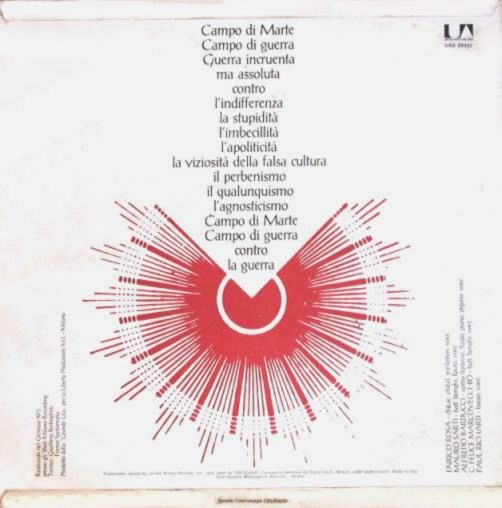 |
|
| Campo di Marte - back cover | |
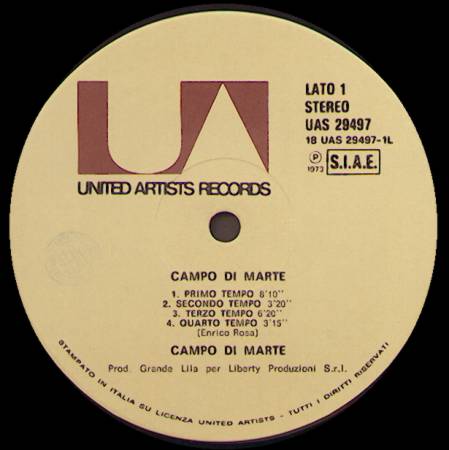 |
|
| LP original label | |
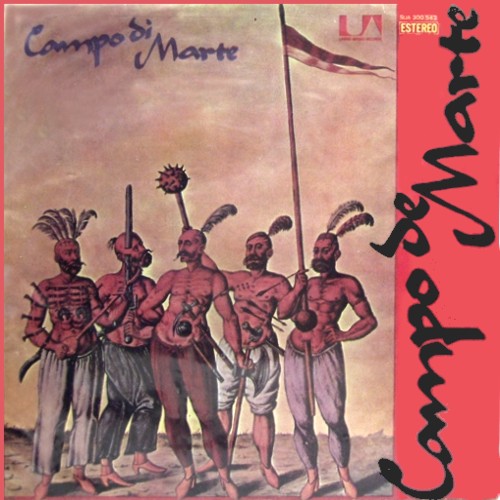 |
|
| Campo di Marte - uruguayan issue | |
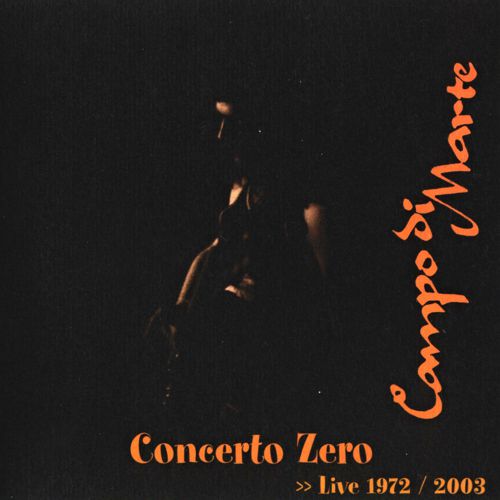 |
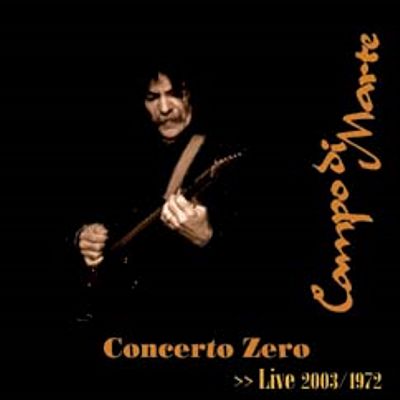 |
| Concerto zero - CD, standard issue (left) and Russian edition (right) | |
![]()
An interview with Enrico Rosa made by Augusto Croce in November 2002
1-What are the origins of Campo di Marte?
I was playing in a group called Senso Unico and we
played in many clubs ("the Pipers") [from the name of a famous club
in Rome, the Piper] of the time and at Space
Electronic in Florence, when I was contacted to replace the guitarist of La
Verde Stagione for a while. So the old drummer of that band, Mauro Sarti, came
to me one day and we began discussing of a new group, and when the short time
with La Verde Stagione was over, we began forming the band, it was at the
beginning of 1971.
Richard Ursillo, born in the States and with a strange florentine/American
accent, was our bassist, a nice though slim guy, that had an interesting wide
range voice, he was him that sang on the album track Terzo Tempo.
Alfredo Barducci was known to me as Carlo, it was a surprise to see his real
name on the cover! Carlo/Alfredo was a graduate French horn player, and he could
play flute and piano as well; I lived with him for a while when we were
preparing the tracks for the recording.
In the same period I Califfi, a well known Florence based pop group, decided to
split and Mauro Sarti knew their drummer Marcovecchio, that wanted to play in a
more progressive style, so they considered of using two drummers in the band,
giving Mauro the freedom to play the flute as well.
2. How come Richard Ursillo was called Paul Richard on the Campo di Marte LP?
His real surname is Ursillo, but as you can hear this doesn't sound so foreign, and, as his second name was Paul, he was renamed Paul Richard.
3- How was the group's name chosen?
At the beginning of our musical project we didn't have
a name, and we changed names many times. We used to play often at Space
Electronic, and in other places, like once with Banco del Mutuo Soccorso when we
even had a good review, under one of these names that I can't remember and that
we soon changed again.
The name Campo di Marte was conceived during the recording session, when we
spent a whole day to find the right name, along with Gian Borasi, director of
United Artists in Italy. When we were losing our hopes, Gian asked us to name
some parts of Florence, and when Campo di Marte was pronounced we all looked at
each other... and that was it!
The name was used as an excuse to write lyrics on the stupidity of wars, and a
picture of turkish mercenary soldiers stabbing themselves with any kind of
weapons to demonstrate their strength and receive higher wages was chosen for
the cover, looking dreadful on the giant posters and creating a grotesque
contrast with the name Campo di Marte [Marte=Mars, the god of war].
4-How was the album composed?
I was more into jazz at the time, with latin and rock
influences, but with such a group of classical trained and rock musicians I had
to find a different style.
So I tried to use at best the French horn interplayed with the flute, creating a
kind of rock music tied to a classical style, and showing the contrasts between
the acoustic instruments and the rock band.
So the music was all based on flute duets, counterpoints between flute, French
horn and electric guitar, and that clean organ sound, almost church-style,
played by Carlo/Alfredo in a very different way from the then popular Hammond
sound. All with a solid background of single drums, double drums, drums and
percussion, and an electric bass always played with a pick by Richard.
5- Were the tracks composed by the whole band?
No, the album was totally composed by me in every
single detail, including every bass or piano line, so it was more a solo project
than a band's work.
The original composition for the record and the live set was opposite to the LP
running order, with the album A-side that was suggested by Borasi as it had a
stronger impact was intended to be the closing part; the musical journey had
been composed to start and end with the same short classical guitar A-major
theme à la Vivaldi, I think this is what was named Quinto tempo on the
album, but the original titles for the tracks were just Prologo parte I &
II, Riflessione and Epilogo.
6-Was the record well promoted?
There was a lot of problems to release the record, and
it was almost two years after the composition that it was recorded, in January
1973, and released.
It was too much for a young musician to keep living that kind of music, so when
we had the chance of playing some important concerts I didn't want to play with
the old group anymore, having already formed a new Campo di Marte that was into
jazz-rock fusion.
So despite the chance of big tours and concerts nothing happened, we were in
Mestre for a megaconcert with Colosseum and other Italian prog groups (and as
Campo di Marte we hadn't played for more than six months), and instead of our
regular set, I decided to play a solo guitar composition along with a short
re-arrangement of the Campo di Marte album. This seems incredible now but I was
such a fool at that time!
7-What happened after the first album?
I recorded a second LP with the new line-up, totally different and provoking for all the people who wanted the old Campo di Marte, and the new group was invited in some Re Nudo [a popular alternative music magazine] tours and other concerts but I managed to ruin everything. Our record company didn't want to release the album that they thought too futuristic and uncommercial, and that was such an offence to me (remember what I said about my foolishness), that despite the Re Nudo concerts and even an offer to join Banco del Mutuo Soccorso as their new guitarist, I decided to leave Italy for Denmark, where a friend had asked me to play for a couple of months.
8-Are there any plans to release the lost second album?
I was contacted by a record company during the 90's to try to release the fusion album, and they also wanted to reissue the first LP. Unfortunately the master tape was kept by Gian Borasi, that I last heard of from Morocco and then from Thailand and nothing else. The first album was reissued in 1994 by Mellow Records.
9-What was the second Campo di Marte line-up?
We were all from Livorno, in the beginning there was
Antonio Favilla (from Capitolo
6) on Fender Rhodes piano, another keyboardist
Franco La Placa on synth, the second guitarist Fabrizio Ughi, a long friend of mine
that had already worked with a good pop band, I Samurai, and with many other
good though unknown rock groups.
On bass we had Sergio Ducilli, on drums one Andrea..., I can't remember his
surname [Colli], and on wah wah tenor sax, flute, ocarina and other odd stuff there was
Fischio, his name was Loriano Berti and he was from Grosseto though he was
living in Livorno. I have spoken with him a few years ago and he lives now in
Abano Terme where he is a musicotherapist, he entered the Vatican Orchestra as
flutist after the Campo di Marte days but I don't have any more details.
This new Campo di Marte worked very seriously, we used to rehearse every day and
we prepared a great stage show, with an unforgettable last concert at the Padova
University. We played to a large audience, there were so many people that some
of them were sitting on a roof close to the hall where we played. There was a
magic atmosphere and so was the music, we had created a great feeling between us
and the improvised parts were very easy and effective, much more than the
arranged parts, and the concert turned out very long and interesting.
10-Did you have any relation with other progressive groups of the time?
When Battiato was still playing electronic music we had
a concert with him, where the old Campo di Marte was involved, I played together
with him and at the end of the concert he gave me a test pressing of the Fetus
LP, and later when it was released he sent me a copy.
Some members of Capitolo 6, Antonio Favilla and
Mauro Romani, were old friends of mine, they came from Livorno [Leghorn] that's
my home town.
I played with Antonio in the second Campo di Marte and later again, along with
Checco Marsella [from I Giganti] and Gianni Bella
for a while when trying to take him away from the drugs, but he went to London
and got mixed up again in the drug scene. He managed to clean himself up after
many years, but his body was so damaged that he died at around 40.
In 1975, during a short time in Italy I played with Renato Rosset, that had just
left New Trolls after their dissolution. I heard
him some years later when I was in Scandinavia and he told me he had moved to
England with Nova.
I recorded with violinist Goran Marianovic, with whom I had played in a Marcella
Bella album, and one of the CBS-Sugar producers wanted us to play Goran's
compositions. The quality of the recording was great, and I'd really like to
have a copy of it, but again it was seen as too avantgarde (I'd rather say too
good!) to be commercially released. It was a shame, because this was really a
great work, with a good bass player from one of the popular prog bands of the
time (I can't remember his name) and his drummer, with which we made a very good
quartet.
I also made some jam sessions with Giulio Capiozzo and Ares Tavolazzi of Area
and even played with the whole group. The idea was to make something closer to
jazz, and Capiozzo also contacted me in Denmark, he wanted to come here to do
something but we never found the way, even due to my wife at the time that was
against my activity as musician.
I came back to Italy in 1976 and I did a lot of sessions for various singers and
a tour with Gianni Bella [an Italian melodic pop singer] when he won the
Festivalbar.
Unfortunately as the years were going by, and with my talent in losing all the
addresses and my notes, I've lost touch with all my old friends.
![]()
Click on pictures to enlarge
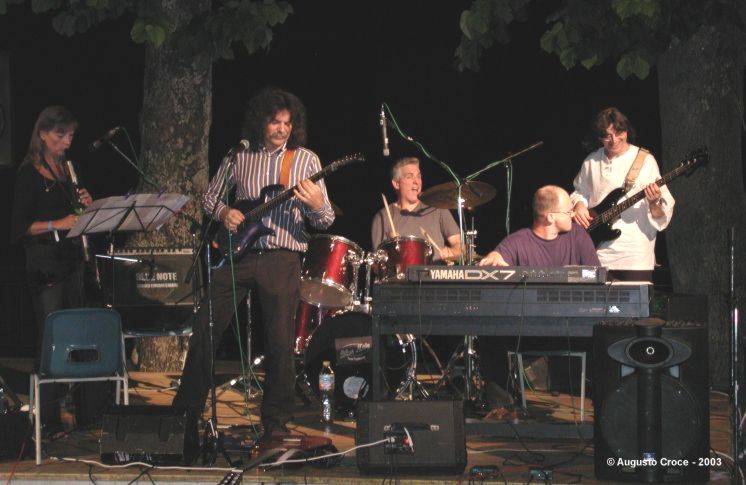 |
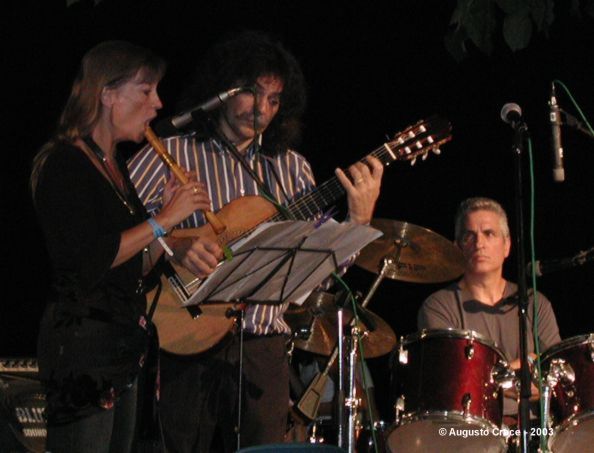 |
| Live in Pelago (FI) 12-jul-2003 - "On the road" Festival | |
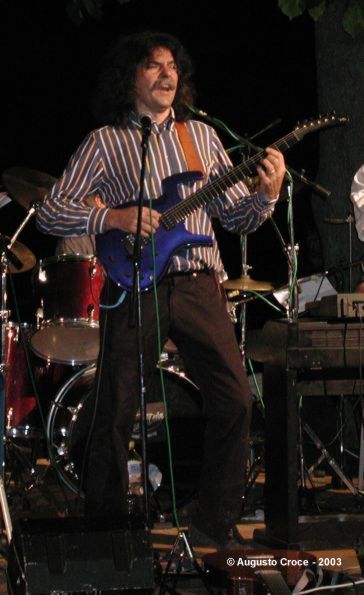 |
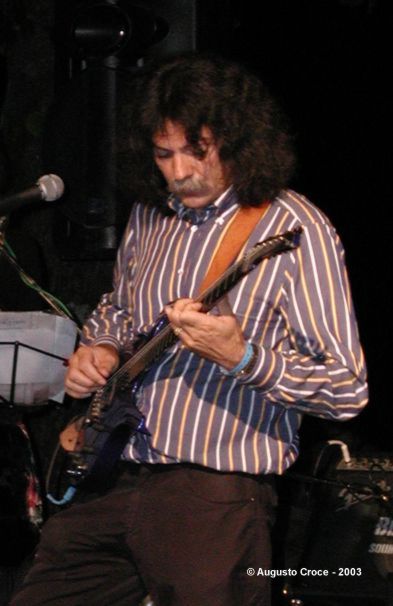 |
| Live in Pelago (FI)
12-jul-2003 - "On the road" Festival Enrico Rosa |
|
![]()
A website on Campo di Marte is finally available at http://www.campodimarte.dk/
![]()
Many thanks to guitarist Enrico Rosa for
the friendship and help with any kind of detailed information on Campo di Marte and the interview.
Thanks to Tino, webmaster of the Sezione
Musica site, for information on the uruguayan issue.